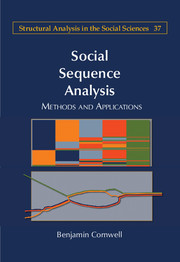Book contents
- Frontmatter
- Contents
- List of Figures
- List of Tables
- Preface
- Acknowledgments
- PART I INTRODUCTION
- PART II THEORETICAL BACKGROUND
- PART III SOCIAL SEQUENCE ANALYSIS CONCEPTS AND TECHNIQUES
- 3 Sequence Analysis Concepts and Data
- 4 Detecting Sequence Structure
- 5 Whole-Sequence Comparison Methods
- PART IV NEW DIRECTIONS IN SOCIAL SEQUENCE ANALYSIS
- PART V CONCLUSIONS
- Appendix A Recent Whole-Sequence Pattern Analyses
- Appendix B Linkage Criteria for Agglomerative Hierarchical Clustering
- References
- Index
- Recent Books in the Series (continued from page iii)
4 - Detecting Sequence Structure
from PART III - SOCIAL SEQUENCE ANALYSIS CONCEPTS AND TECHNIQUES
Published online by Cambridge University Press: 05 July 2015
- Frontmatter
- Contents
- List of Figures
- List of Tables
- Preface
- Acknowledgments
- PART I INTRODUCTION
- PART II THEORETICAL BACKGROUND
- PART III SOCIAL SEQUENCE ANALYSIS CONCEPTS AND TECHNIQUES
- 3 Sequence Analysis Concepts and Data
- 4 Detecting Sequence Structure
- 5 Whole-Sequence Comparison Methods
- PART IV NEW DIRECTIONS IN SOCIAL SEQUENCE ANALYSIS
- PART V CONCLUSIONS
- Appendix A Recent Whole-Sequence Pattern Analyses
- Appendix B Linkage Criteria for Agglomerative Hierarchical Clustering
- References
- Index
- Recent Books in the Series (continued from page iii)
Summary
This chapter presents techniques for detecting important structural features of sequences. This includes an account of approaches to describing sequence structure (i.e., descriptive statistics, visual aids, and transition matrices) and techniques for measuring and assessing the statistical significance of key structural properties (e.g., Markov chains) based on probabilistic comparisons. Some key topics here include sequence length, frequencies of elements, and measures of sequential connection, sequence stationarity, and homogeneity of sequences across subjects. Some of these measures may be of intrinsic interest, especially in cases where little is known about a sequence's structure. In these cases, measures may be more useful for operationalizing structural concepts that can then be analyzed by other means, such as regression analysis.
To keep this discussion focused on informative techniques that can be useful in applied research, I set aside some fundamental lessons concerning probability theory and statistical inference. For example, I do not discuss properties of the binomial distribution, which can be useful, for example, in calculating the likelihood of observing a given element in a given position. I also do not address Markov models in detail. A large number of other works authoritatively address the mathematics underlying influential forms of sequence analysis and some sequence measures (e.g., Bakeman and Gottman 1997; Brockwell and Davis 2009; Chatfield 2003; Fuller 2009; Gottman and Roy 1990; Meyn, Tweedie, and Glynn 2009; Shumway and Stoffer 2010). The remainder of this book describes techniques that build on this work, but with an eye toward practical applications.
Descriptive Analysis
Several elementary properties of sequences can convey a lot of information about sequence structure. This section covers the most commonly reported aspects of sequences. Many of the descriptive measures discussed in this section can be calculated easily using Stata's SQ sequence analysis package (Brzinsky-Fay, Kohler, and Luniak 2006) and R's TraMineR package (Gabadinho et al. 2009).
4.1.1 Sequence Length
One of the most important features of a sequence is its length. Sequence length, which is captured in t, refers to the number of positions within the sequence in which elements (or gaps) may appear.
- Type
- Chapter
- Information
- Social Sequence AnalysisMethods and Applications, pp. 83 - 108Publisher: Cambridge University PressPrint publication year: 2015



